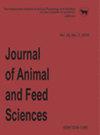The content of raffinose oligosaccharides in legumes and their importance for animals
IF 1.5
4区 农林科学
Q3 AGRICULTURE, DAIRY & ANIMAL SCIENCE
引用次数: 2
Abstract
In recent years, there has been a growing interest in the use of legume seeds for human and animal nutrition for various reasons. Independence from the import of genetically modified soybean products, feed quality and price play an important role in animal nutrition (Święcicki et al., 2020). Legume seeds are a rich source of nutrients for humans, thus their consumption prevents various diseases of civilization, such as hypertension, type 2 diabetes, hyperlipidaemia, and overweight (Conti et al., 2021). Legumes can fix atmospheric nitrogen, improve soil physical condition, require lower energy input (Rubiales and Mikic, 2015) and perfectly complement crop rotation. It is well known that legumes also contain antinutrients (Gulewicz et al., 2014), such as trypsin inhibitors, lectins, phytic acid, tannins, quinolizidine alkaloids, saponins, and raffinose family oligosaccharides (RFOs). They have a diverse structure, and their activity and concentration in seeds are species-specific. Chemically, these compounds are sucrose homologues with (1→6) glycosidic linkages of galactose molecules. RFOs perform critical physiological functions. They increase drought and low temperature resistance, are responsible for respiration during germination, and extend the shelf life of legumes (Gu et al., 2018). Although RFOs are considered antinutrients for animals (Banti, 2021), recently these compounds have been recognized as functional substances with ABSTRACT. The interest of consumers, as well as the food and feed industry in legumes is constantly increasing. However, the use of legume seeds is limited by the fact that they contain various non-nutritive compounds such as raffinose family oligosaccharides (RFOs). On the other hand, RFO compounds are considered prebiotic substances improving health and growth of organisms. Our study consisted in the long-term monitoring of RFO contents in seeds of several legumes cultivated in Poland. The seeds of pea (25 cultivars), faba bean (5 cultivars), and lupins (41 cultivars) were harvested between 2013 and 2019, whereas soybean seeds (27 cultivars) were harvested between 2015 and 2019. The analysis showed that the content of RFOs in soybean seeds ranged from 33.75 to 69.30 mg per g dry matter (DM), 57.23 to 130.38 mg/g DM in lupin seeds – 52.03 to 80.60 mg/g DM in pea seeds, and from 32.15 to 65.17 mg/g DM in faba bean seeds. Yellow lupin seeds had the highest total RFO contents in DM, whereas faba bean and soybean seeds showed the lowest RFO contents. Stachyose was the dominant oligosaccharide in all soybean and lupin seeds, while verbascose was the dominant oligosaccharide in most pea and faba bean seeds. Some pea cultivars contained more stachyose than verbascose. Crop species, cultivar, growing environment, and processing methods determine the suitability of individual seeds for the feed and food industry. Received: 24 February 2022 Revised: 19 April 2022 Accepted: 2 May 2022豆类中棉子糖低聚糖的含量及其对动物的重要性
近年来,由于各种原因,人们对将豆类种子用于人类和动物营养越来越感兴趣。独立于转基因大豆产品的进口,饲料质量和价格在动物营养方面发挥着重要作用(wiÉcicki等人,2020)。豆类种子是人类丰富的营养来源,因此食用豆类可以预防各种文明疾病,如高血压、2型糖尿病、高脂血症和超重(Conti等人,2021)。豆类可以固定大气中的氮,改善土壤物理条件,需要更低的能量输入(Rubiales和Mikic,2015),并完美地补充作物轮作。众所周知,豆类还含有抗营养物质(Gulewicz等人,2014),如胰蛋白酶抑制剂、凝集素、植酸、单宁、喹啉生物碱、皂苷和棉子糖家族低聚糖(RFO)。它们具有多样的结构,它们在种子中的活性和浓度是特定物种的。在化学上,这些化合物与(1)是蔗糖同源物→6) 半乳糖分子的糖苷键。RFO具有关键的生理功能。它们增加了对干旱和低温的抵抗力,在发芽过程中负责呼吸,并延长了豆类的保质期(Gu et al.,2018)。尽管RFO被认为是动物的抗营养物质(Banti,2021),但最近这些化合物已被公认为具有“摘要”功能的物质。消费者以及食品和饲料行业对豆类的兴趣不断增加。然而,豆类种子的使用受到限制,因为它们含有各种非营养性化合物,如棉子糖家族低聚糖(RFO)。另一方面,RFO化合物被认为是改善生物体健康和生长的益生元物质。我们的研究包括对波兰种植的几种豆类种子中RFO含量的长期监测。豌豆(25个品种)、蚕豆(5个品种)和羽扇豆(41个品种)的种子在2013年至2019年期间收获,而大豆种子(27个品种)在2015年至2019年间收获。分析表明,大豆种子中RFO的含量范围为33.75至69.30 mg/g干物质(DM),羽扇豆种子为57.23至130.38 mg/g DM——豌豆种子为52.03至80.60 mg/g DM,蚕豆种子为32.15至65.17 mg/g DM。黄羽扇豆种子的总RFO含量在DM中最高,而蚕豆和大豆种子的RFO含量最低。水苏糖是所有大豆和羽扇豆种子中的主要低聚糖,而马鞭草糖是大多数豌豆和蚕豆种子中的主导低聚糖。一些豌豆品种含有比马鞭草糖更多的水苏糖。作物种类、栽培品种、生长环境和加工方法决定了单个种子对饲料和食品工业的适用性。接收日期:2022年2月24日修订日期:2022年底4月19日接受日期:2022年初5月2日
本文章由计算机程序翻译,如有差异,请以英文原文为准。
求助全文
约1分钟内获得全文
求助全文
来源期刊

Journal of Animal and Feed Sciences
农林科学-奶制品与动物科学
CiteScore
2.10
自引率
0.00%
发文量
42
审稿时长
3 months
期刊介绍:
Journal of Animal and Feed Sciences (JAFS, J. Anim. Feed Sci.) has been published by the Kielanowski Institute of Animal Physiology and Nutrition, Polish Academy of Sciences in Jabłonna (Poland) since 1991. It is a continuation of the Polish-language journal Roczniki Nauk Rolniczych. Seria B, Zootechniczna published by the Polish Academy of Sciences since 1969.
JAFS is an international scientific journal published quarterly, about 40 papers per year including original papers, short communications and occasionally reviews. All papers are peer-reviewed and related to basic and applied researches in the field of animal breeding and genetics, physiology of nutrition, animal feeding, feed technology and food preservation. The journal distinguishes the multidisciplinary nature of physiological and nutritional sciences and so includes papers specialized in all fields connected with animal well-being, including molecular and cell biology and the emerging area of genetics.
 求助内容:
求助内容: 应助结果提醒方式:
应助结果提醒方式:


